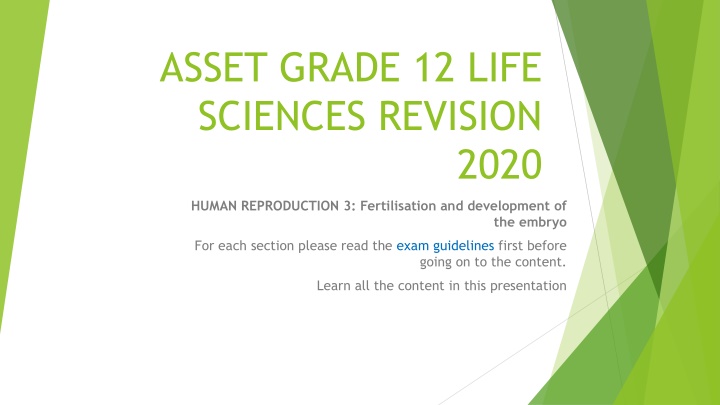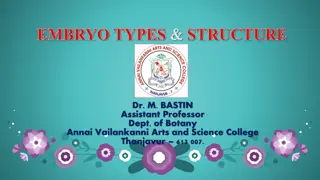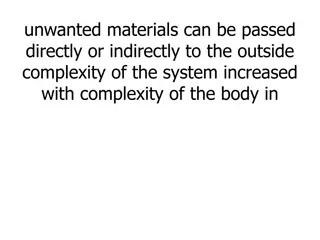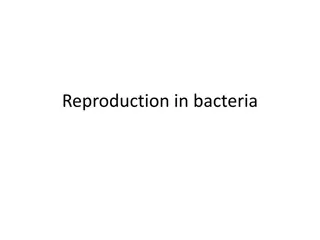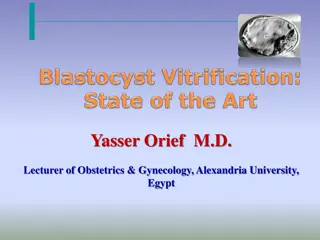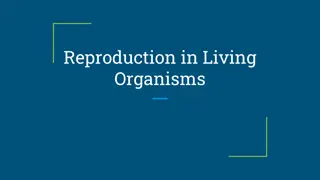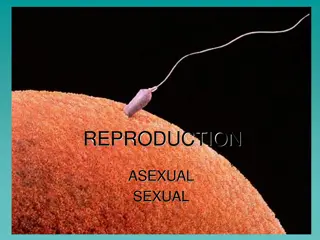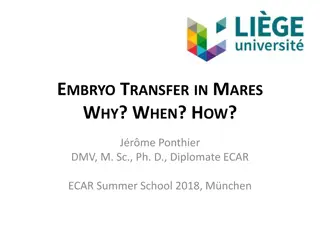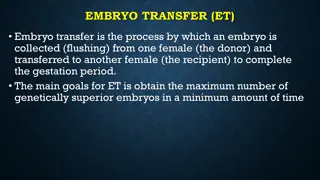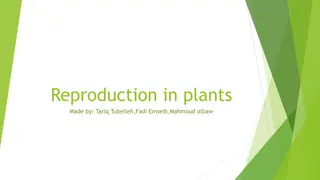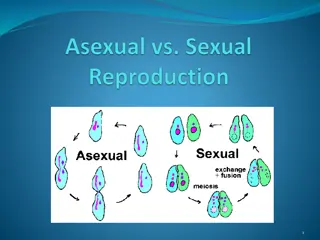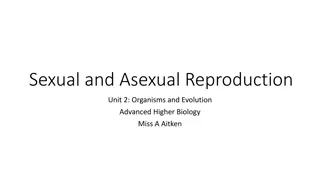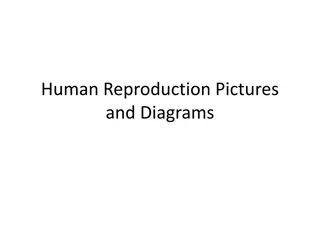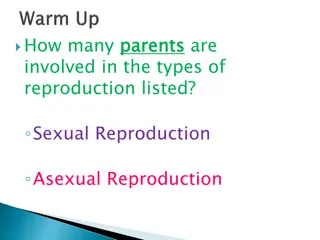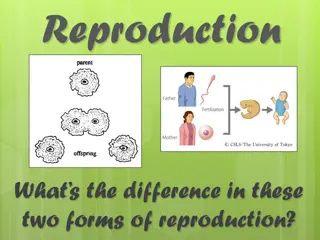Human Reproduction: Fertilisation and Embryo Development Overview
Human reproduction involves the complex processes of fertilisation and embryo development. Fertilisation occurs when the nucleus of a sperm cell fuses with the nucleus of an ovum to form a zygote. The zygote undergoes mitosis to develop into a blastocyst, which then implants into the endometrium. This presentation covers the stages of copulation, ovulation, fertilisation, and the development of the zygote into a blastocyst and embryo in detail.
Download Presentation

Please find below an Image/Link to download the presentation.
The content on the website is provided AS IS for your information and personal use only. It may not be sold, licensed, or shared on other websites without obtaining consent from the author.If you encounter any issues during the download, it is possible that the publisher has removed the file from their server.
You are allowed to download the files provided on this website for personal or commercial use, subject to the condition that they are used lawfully. All files are the property of their respective owners.
The content on the website is provided AS IS for your information and personal use only. It may not be sold, licensed, or shared on other websites without obtaining consent from the author.
E N D
Presentation Transcript
ASSET GRADE 12 LIFE SCIENCES REVISION 2020 HUMAN REPRODUCTION 3: Fertilisation and development of the embryo For each section please read the exam guidelines first before going on to the content. Learn all the content in this presentation
Definitions: Copulation is to engage in sexual intercourse when the penis is inserted into the vagina to ensure that internal fertilisation takes place Ovulation: Graafian follicle bursts (at the edge of the ovary) to release an egg or ovum usually on day 14 of the menstrual cycle Fertilisation is the fusion of the nucleus of a sperm cell with the nucleus of a ovum to form a diploid zygote. Development of the embryo takes place from where it is a single zygote to the blastocyst, and this takes place by mitosis Implantation is when the embryo/blastocyst embeds itself in the endometrium by sinking into it Embryo: this is a stage in the development of the zygote from the morula to the blastocyst until 8 weeks of gestation Foetus: The baby is referred to as a foetus after 8 weeks of gestation Gestation is the process whereby a foetus develops inside the uterus until birth takes place (refer to vivipary)
Process of fertilisation During copulation, the male ejaculates semen (5cm3) containing sperm into the top of the female s vagina. Between 100 300 million sperm are released during ejaculation. So many are necessary because many fail to complete the long journey to where fertilization takes place. Sperms swim through the cervix into the uterus (muscular contractions of the uterus during intercourse aid the movement of the sperm up the uterus) and up the Fallopian tubes. A ripe ovum must be present in the upper third of the oviduct/fallopian tube for fertilization to occur. Sperm live for 4 7 days (some up to 10), so if ovulation takes place after intercourse, fertilization could occur up to 4 7 and even 10 days after intercourse. A released ovum can survive up to 24 hours. The ovum is surrounded by a membrane which the sperm must penetrate. The first sperm to reach the ovum releases a chemical which softens the membrane and the point of contact, allowing the sperm to move through the membrane and into the cytoplasm of the ovum. Immediately after penetration, the membrane undergoes rapid changes which make it thicker and now acts as a barrier so that no other sperm can penetrate it. Only the head of the sperm enters the ovum. The head moves towards the nucleus of the ovum and the two fuse together. This brings together the hereditary characteristics of both the mother and the father. This is called fertilisation.
Development of zygote to blastocyst Describe the following development: zygote, morula, blastocyst and embryo Zygote single diploid cell carrying chromosomes from father and mother. Divides by mitosis to form a morula Moves from the Fallopian tube into the uterus. Divides further to form a blastocyst On about day 8-9 the blastocyst implants into the endometrium
Implantation Describe implantation including the role of progesterone in maintaining pregnancy Cells reach uterus and form a hollow, fluid filled ball of about 100 cells called a blastocyst This attaches to the endometrium during implantation and it now usually called an embryo. The endometrium has secreted chemicals to make it receptive to the blastocyst which sinks into the endometrium and is surrounded by a pool of the mother s blood. (Takes about a week) Blastocyst secretes a hormone which keeps corpus luteum functioning (ie will not degenerate) Progesterone and oestrogen are secreted by the corpus luteum to keep the lining of uterus (which is full of blood vessels) thick AND ensures that embryo stays attached to the endometrium
Gestation Identify and state the functions of the following parts of the developing embryo/foetus: Chorion and chorionic villi: The chorion is the outermost membrane surrounding a developing foetus and it gives rise to the chorionic villi after implantation. Functions of the chorionic villi: The chorionic villi form part of the placenta and are used for exchange of substances with the mother's blood, They prevent the mother s blood from mixing with the baby s blood The Amnion and Amniotic Fluid: The amnion (sac) is a strong membrane that is filled with amniotic fluid that surrounds the developing foetus. The amniotic fluid is 99% water. Functions of the Amniotic Fluid: It supports the developing foetus and allows it to move freely in a safe environment. It cushions and protects against external injury and impact, such as bumps and knocks. It provides a medium in which the foetus practises breathing and swallowing movements. It holds urine as it is released from the foetus It protects against changes in temperature and dehydration.
The Umbilical Cord: The umbilical cord is a flexible cord extending from the abdomen of the foetus to the placenta. Functions of the Umbilical Cord: The umbilical artery leaves the foetus and goes to the placenta and mother s blood system and removes waste The umbilical vein goes from the mother s blood system and placenta to the foetus carrying food, antibodies, oxygen. The Placenta: The placenta is a disc shaped organ that connects the blood supply of the mother and the foetus. The foetal and mother s blood DO NOT mix substances move through blood capillaries that have thin walls. Functions of the Placenta: Oxygen and dissolved food substances (glucose, amino acids and fatty acids, vitamins) pass from the mother to the foetal blood system for respiration and nutrition. Foetal waste products from Metabolism (carbon dioxide and urea) pass into the mother s blood system for excretion. Some maternal antibodies pass to the foetus providing immunity. The placenta acts as a barrier to microorganisms some drugs from entering the foetus from the mother. However, some diseases like German measles and HIV can pass through the placenta. Alcohol and illegal drugs can pass through and cause significant damage to the developing foetus. The placenta acts as a physical attachment of the foetus to the wall of the uterus. The placenta secretes progesterone and oestrogen to maintain the pregnancy.
Gestation - hormones State the role of oestrogen and progesterone in maintaining pregnancy link to endometrium
Contraceptives no longer in CAPS but must be able to apply knowledge Good luck with your studying for the exams
